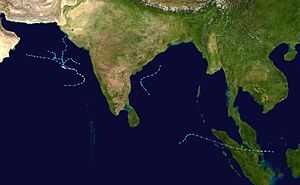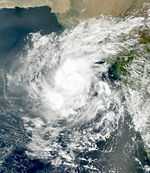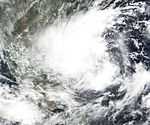2001 North Indian Ocean cyclone season
| |
| Season summary map |
| First system formed |
May 21, 2001 |
| Last system dissipated |
January 1, 2002 |
| Strongest storm |
ARB 01 – 932 hPa (mbar), 215 km/h (130 mph) (3-minute sustained) |
| Deep depressions |
7 |
| Cyclonic storms |
5 |
| Very severe cyclonic storms |
1 |
| Super cyclonic storms |
0 |
| Total fatalities |
108 |
| Total damage |
Unknown |
North Indian Ocean tropical cyclone seasons
1999, 2000, 2001, 2002, 2003 |
The 2001 North Indian Ocean cyclone season had no bounds, but cyclones tend to form between April and December, with peaks in May and November. These dates conventionally delimit the period of each year when most tropical cyclones form in the northern Indian Ocean.
Season summary

Four tropical cyclones were observed, less than the average of 5-6. Of those, 1 reached Cyclone strength.
Very Severe Cyclonic Storm ARB 01
| Very severe cyclonic storm (IMD) |
| Category 3 tropical cyclone (SSHWS) |
|
|
| Duration |
May 21 – May 28 |
| Peak intensity |
215 km/h (130 mph) (3-min) 932 mbar (hPa) |
A weak disturbance that formed east of Somalia was detected on May 18. By May 21 a tropical depression developed after the system formed a closed mid-level circulation. It tracked eastward across the Arabian Sea, but turned northward abruptly short of the Indian coast. Tropical Depression 01A became a tropical storm late on the 21st, and reached cyclone strength on the 22nd. While drifting northwestward on the 24th, Cyclone 01A became an intense cyclone with 125 mph winds over the open waters. Upper level shear weakened it to a tropical depression three days later. Moving northward, the storm briefly re-strengthened to a 65 mph storm before striking western India on the 28th and dissipating.
Ahead of the storm, all ports in Gujarat, including Kandla, one of the largest in the country, were closed as a precautionary measure.[1] Over 10,000 people were evacuated from coastal areas in the threatened region. Offshore, between 1,500 and 2,000 fishing vessels had lost contact with the mainland.[2]
Depression
| Depression (IMD) |
|
|
| Duration |
June 12 – June 13 |
| Peak intensity |
45 km/h (30 mph) (3-min) 990 mbar (hPa) |
A depression that formed on June 12 in the Bay of Bengal lashed the Orissa coast until June 13. The storm had maximum sustained winds of 25 knots and a minimum pressure of 990 mb.
Cyclonic Storm ARB 02
| Cyclonic storm (IMD) |
| Tropical storm (SSHWS) |
|
|
| Duration |
September 25 – September 28 |
| Peak intensity |
65 km/h (40 mph) (3-min) 1000 mbar (hPa) |
The Indian Meteorological Department classified the system as a depression on the 25th. Initially it was forecast to strengthen into a 50-kt system and make landfall on the southern end of the Arabian Peninsula, but the cyclone weakened and dissipated on September 28.
Cyclonic Storm ARB 03
| Cyclonic storm (IMD) |
| Tropical storm (SSHWS) |
|
|
| Duration |
October 7 – October 13 |
| Peak intensity |
65 km/h (40 mph) (3-min) 998 mbar (hPa) |
Tropical Cyclone 3A was a weak tropical storm briefly formed over the Arabian Sea, but weakened due to an entrainment of dry air to its north.
Cyclonic Storm BOB 01
| Cyclonic storm (IMD) |
|
|
| Duration |
October 14 – October 17 |
| Peak intensity |
65 km/h (40 mph) (3-min) 998 mbar (hPa) |
A tropical cyclone formed in the Bay of Bengal and was briefly tracked by the Indian Meteorological Department until it made landfall in Andhra Pradesh.
Depression BOB 02
| Depression (IMD) |
| Tropical depression (SSHWS) |
|
|
| Duration |
November 9 – November 12 |
| Peak intensity |
45 km/h (30 mph) (3-min) 1004 mbar (hPa) |
The fourth tropical storm of the year formed on November 9 in the Bay of Bengal. It tracked northward, paralleling the Indian coastline offshore before dissipating from upper level shear on the 12th.
Tropical Cyclone Vamei
| Tropical storm (SSHWS) |
|
|
| Duration |
December 29, 2001 (Entered basin) – January 1, 2002 |
| Peak intensity |
65 km/h (40 mph) (1-min) 997 mbar (hPa) |
The near-equator Typhoon Vamei crossed Indonesia and reached the Indian Ocean on December 29 and became a tropical cyclone. It restrengthened to a tropical storm on the 30th, but upper level winds caused it to dissipate on January 1, 2002.
See also
References
External links
| 2000–2009 North Indian Ocean cyclone seasons |
|---|
| |
|













